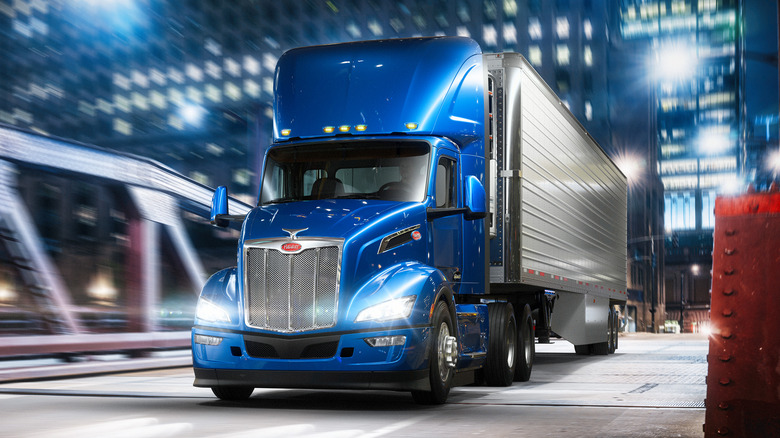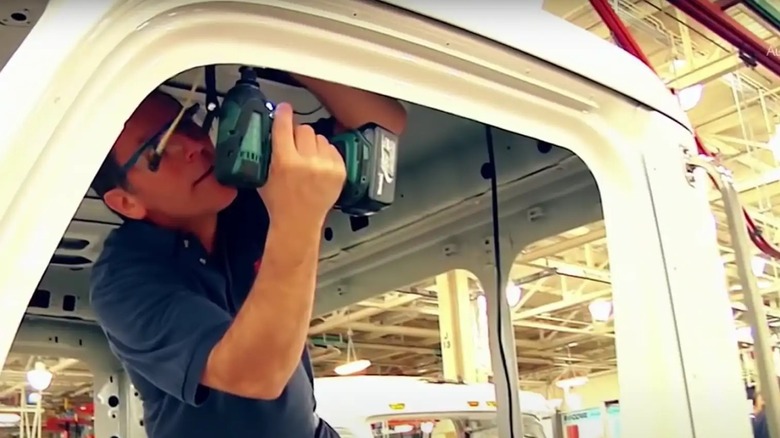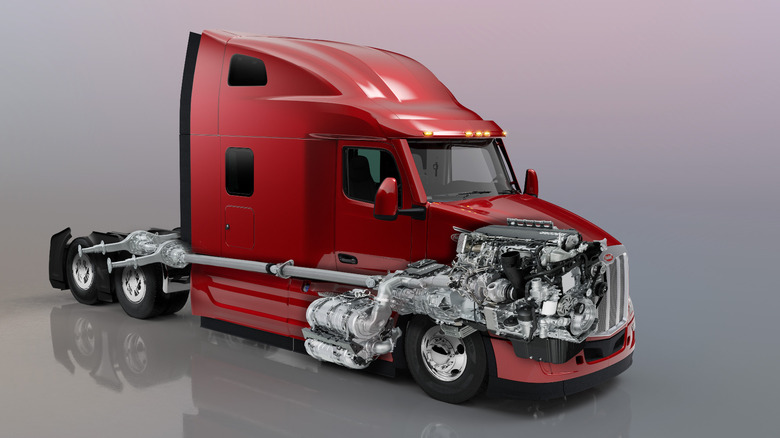Who Makes Peterbilt Trucks & What Engines Power Them?
Peterbilt trucks are a familiar presence on US roads. If you're often driving alongside freight traffic, you'll probably spot them with their bright red oval badges at least a couple of times a day. Over the years, Peterbilt has established itself as a supplier of long-haul trucks known for their high-end, comfortable sleeper cabs. And as of 2024, its market share for Class 8 vehicles stands at 15.3%. Nine percent of the medium-duty trucks on the road are made by Peterbilt as well.
Interestingly, Peterbilt is also present in pop culture. Transformers geeks know the brand, specifically the 1992 Model 379, as the semi-truck form of Optimus Prime in the first three live-action movies. If you're a fan of Jaws and E.T. director Steven Spielberg, then you might have also seen the infamous Peterbilt truck in Spielberg's breakout movie, Duel.
With Peterbilt being a popular truck manufacturer for decades now, you might wonder who exactly makes these trucks and what kind of engines are used in them. Let's find out.
Who makes Peterbilt trucks?
Peterbilt trucks are made and owned by PACCAR, the same global company who owns Kenworth. When founder T.A. Peterman started Peterbilt in 1939, the company was producing its own trucks. However, PACCAR, then Pacific Car & Foundry, bought out the truck business in 1958 and has served as its parent company to this day. This move boosted Peterbilt's manufacturing capacity as it allowed the brand to use PACCAR's plants.
Peterbilt trucks are now manufactured in three factories across North America: one in the United States, one in Canada, and one in Mexico. The main plant — which happens to be one of its oldest, too — is based in the US, specifically in Denton, Texas. Established in 1980, the facility produces Peterbilt's Class 8 heavy-duty trucks, and in 2024, it had the honor of rolling out the brand's 800,000th unit.
The manufacturing sites in Canada and Mexico are both owned by PACCAR, so they're technically not exclusive to assembling Peterbilt models. The plant in Sainte-Thérèse, Quebec, for instance, is primarily focused on building medium-duty trucks like the Peterbilt Model 548, but also Kenworth medium-duty conventionals like the T180 and T280. This 425,000 square-foot facility started operating in the late 1990s. Meanwhile, the Mexico factory in Mexicali, Baja California, sits on an impressive 660,000 square feet site. It opened in 1959 and is where Class 5 to 8 vehicles for both the Peterbilt and Kenworth nameplates are developed.
What engines do Peterbilt trucks use?
There are two engine brands that power Peterbilt trucks: PACCAR and Cummins. The PACCAR engines include MX-13, MX-11, PX-9, and PX-7, while the Cummins models are limited to X15, ISX12N, L9N, and B6.7N. Among these engines, the most powerful — Cummins X15 — is an option for only three Class 8 trucks, Model 579, 589, and 567. This inline six-cylinder engine can crank out a maximum of 605 hp and a peak torque of 2,050 lb-ft, all from a 15L displacement. Models 579, 589, and 567 can also be equipped with the 12.9L PACCAR MX-13. It's rated at up to 510 horsepower and 1,850 lb-ft peak torque.
In terms of popularity, the most common engine option for most of the Peterbilt trucks is the Cummins L9N. It's available for six out of the nine current models. The Cummins L9N features an 8.9L displacement and delivers 320 horsepower and 1,000 lb-ft peak torque. Although it's considered a medium-duty engine, it can be outfitted in most of Peterbilt's Class 8 trucks.
For Peterbilt's medium-duty lineup (Models 548, 537, 536, 535, and 220), each one of the trucks can come with the PACCAR PX-7. This 6.7L inline six-cylinder engine is capable of hitting a peak torque of 750 lb-ft and putting out between 280 to 325 horsepower. The medium-duty models 548, 537, and 536 have the option for a PACCAR PX-9 engine, too. Compared to the PX-7, it performs better with its 8.9L displacement, 260 to 450hp output, and 860 to 1,250 lb-ft peak torque.


